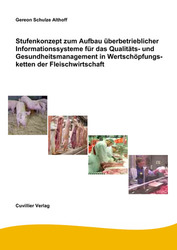| Departments | |
|---|---|
| Book Series (96) |
1378
|
| Nachhaltigkeit |
3
|
| Gesundheitswesen |
1
|
| Humanities |
2364
|
| Natural Sciences |
5406
|
| Mathematics | 229 |
| Informatics | 319 |
| Physics | 980 |
| Chemistry | 1363 |
| Geosciences | 131 |
| Human medicine | 243 |
| Stomatology | 10 |
| Veterinary medicine | 108 |
| Pharmacy | 147 |
| Biology | 835 |
| Biochemistry, molecular biology, gene technology | 121 |
| Biophysics | 25 |
| Domestic and nutritional science | 45 |
| Agricultural science | 1004 |
| Forest science | 201 |
| Horticultural science | 20 |
| Environmental research, ecology and landscape conservation | 148 |
| Engineering |
1793
|
| Common |
98
|
|
Leitlinien Unfallchirurgie
5. Auflage bestellen |
|
Advanced Search
Stufenkonzept zum Aufbau überbetrieblicher Informationssysteme für das Qualitäts- und Gesundheitsmanagement in Wertschöpfungsketten der Fleischwirtschaft (English shop)
Gereon Schulze-Althoff (Author)Preview
Table of Contents, Datei (33 KB)
Extract, Datei (82 KB)
Beschreibung zum Buch:
Es besteht ein weitgehender Konsens über den Bedarf und Nutzen von überbetrieblichen Informationssystemen für Aufgaben im Qualitäts- und Gesundheitsmanagement in Wertschöpfungsketten der Fleischerzeugung. Forderungen nach überbetrieblichem Informationsaustausch zwischen Tierhaltern, Schlachthöfen, Fleischverarbeitungsunternehmen und Behörden finden sich bereits im neuen EU-Lebensmittelhygiene-Recht. Daher sind praxiserprobte Konzepte gefragt, die es verantwortlichen Koordinatoren erleichtern, überbetriebliche Informationssysteme einzuführen. Aufbauend auf den Ergebnissen aus drei umfangreichen Pilotumsetzungen wird in dieser Arbeit ein Vorgehensmodell zum Aufbau überbetrieblicher Informationssysteme vorgestellt. Das Modell definiert sechs voneinander abgegrenzte Arbeitsschritte als Stufen. Zwei Stufen beziehen sich dabei auf die Vorgehensweise bei der Planung und Vorbereitung; vier anschließende Stufen beschreiben Schritte zur Einführung und Nutzung überbetrieblicher Informationssysteme.
Die Arbeit richtet sich einerseits an Wissenschaftler der Agrarwissenschaften, der Veterinärmedizin und der Qualitätswissenschaften sowie Experten in Systementwicklungshäusern. Andererseits sollen die Ergebnisse Verantwortliche in Unternehmen der Fleischerzeugung und ihre Dienstleister unterstützen, vorhandene Informationen besser für den kontinuierlichen Verbesserungsprozess zu nutzen.
Abstract in English
The aim of this research was to develop a concept that supports the design and implementation of inter-organisational information systems for quality and animal health management in meat supply chains and networks.
The challenge within this research was the integration of two aspects into one methodological approach, namely the controlling of relatively uniform processes that are mainly biologically and technically determined, and the existence of complex and heterogeneous contractual and organisational arrangements in meat chains. Existing theoretical models, a systems approach to controlling within a preventive health management context, the netchain model that integrates horizontal and vertical dimensions in distributed production cycles and the process model in quality management are incorporated into one approach for inter-organisational quality and health management that forms the theoretical framework of this research.
It is concluded that the key requirements for inter-organisational information systems in meat chains can efficiently be met using Data Warehouse technology. To facilitate the design of a flexible implementation model for the heterogeneous structures in the meat industry Data Warehouse systems in three different pork pilot chains were designed, implemented and tested under complementary goals:
1. to extend the advisory services for piglet producers and fatteners through improved use of process data from the different actors
2. to support information exchange between fatteners and slaughterhouses as a key requirement for the risk based meat inspection
3. to improve the use of quality relevant information through standardised information exchange between slaughterhouse and meat processing companies.
Main product of this research a model for the implementation of inter-organisational information systems in pork chains has been developed. It defines six subsequent implementation steps. The first two support planning and preparation for the implementation, four following steps support design, implementation and use of an inter-organisational information system.
Key Words: Informationen zur Lebensmittelkette, Food chain information, Supply chain management, Netchain, Data Warehouse, Quality, Meat chain, Stufenkonzept, Fleischwirtschaft
| ISBN-13 (Printausgabe) | 3865378277 |
| ISBN-13 (Hard Copy) | 9783865378279 |
| ISBN-13 (eBook) | 9783736918276 |
| Language | German |
| Page Number | 176 |
| Edition | 1 Aufl. |
| Volume | 0 |
| Publication Place | Göttingen |
| Place of Dissertation | Bonn |
| Publication Date | 2006-04-03 |
| General Categorization | Dissertation |
| Departments |
Agricultural science
|








